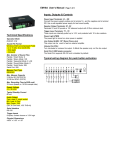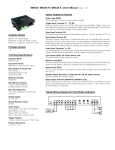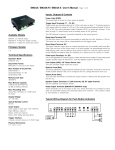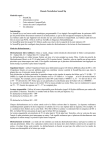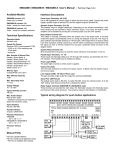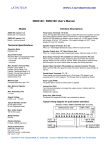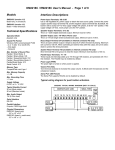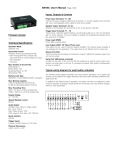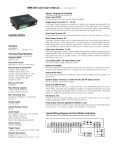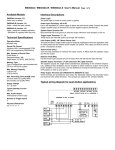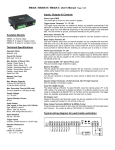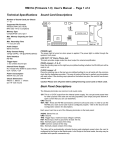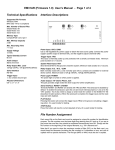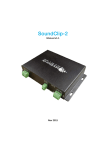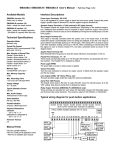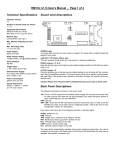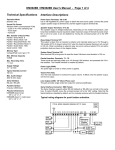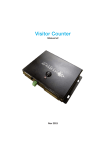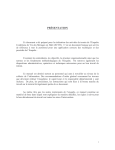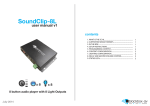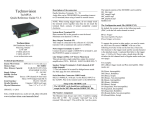Download USER`S MANUAL - Sound Directions
Transcript
USER’S MANUAL Hardware requirements: • • • • • SoundClip Power supply (up to 32V 1.5A for maximum output) CompactFlash memory card CompactFlash card reader A computer Introduction The SoundClip is a programmable digital audio player. It is fitted with a built-in 40 W power amplifier that allows it to be directly connected to a loudspeaker, making it a compact and highly versatile device. The sound files played back by the device are stored on a removable CompactFlash (CF) memory card. The sound files have to be mono PCM type, 16 bit and 22.05 or 44.1kHz sampling rate. The SoundClip can read up to 512 sound files of any length subject to the capacity of the CF card. The SoundClip can be configured in several trigger and playback operating modes: - Trigger modes: Direct trigger (default): In this mode each input directly triggers a corresponding file: T1 = File 001, T2 = File 002, T8 = File 008. A trigger is valid when the input is shorted to the ground for at least 50 ms. The Direct Trigger is prioritised from T1 (the highest) to T8 (the lowest). However, it does not mean a higher priority input can interrupt a lower one. It only means that if multiple triggers are applied at the same time, the highest priority wins. Binary Trigger: Use the binary trigger to trigger up to 128 different files ranging from 001 to 128. The Binary Trigger is often preferred when an external controller controls the SoundClip because, in most cases, it requires less I/O ports. To trigger a particular file, the first step is to signal the file number on T1 (LSB) ~ T7 (MSB). The signal must be in the binary format with +5V being logic “1”, and 0V (the ground) being logic “0”. For example, to signal File 007 (binary code “0000111”), T1 ~ T3 should be at +5V, and T4 ~ T7 should be at 0V. Note that, as a special case, the binary code for File 128 is “0000000”. The second and the last step is to short T8 to the ground for at least 50 ms while maintaining the signal on T1 ~ T7. Afterwards, signals on T1 ~ T7 don’t matter any more. Sequential Trigger: Use the sequential trigger to sequentially trigger up to 99 different files per input as defined below. However, the total number of files cannot exceed 512. T1 triggers File 001 ~ 099 T2 triggers File 201 ~ 299 ...... T8 triggers File 801 ~ 899 Each trigger on the same input activates the next file in the sequence. The sequence automatically restarts when either the end of the sequence is reached or there is a break in the sequence. For example, if there are only three files on the flash card: 001, 002, and 004, the system will only sequence from 001 to 002. File 004 will never be played because File 003 is missing. The sequential trigger is prioritised from T1 (the highest) to T8 (the lowest). However, it does not mean a higher priority input can interrupt a lower one. It only means that if multiple triggers are applied at the same time, the highest priority wins. Round-Robin Trigger: This mode is very similar to the Direct Trigger mode except that the inputs are not prioritized. So if multiple inputs are tied to ground then their files will be played one after another, instead of just the highest priority one. Round-Robin mode can only be used in conjunction with Non-interruptible Playback and Script Playback. - Playback modes: The playback mode defines how the playback is to proceed. These playback modes do not apply when the system is controlled via the optional serial port. Non-interruptible Playback (default): The file is played once per trigger. The playback is not interruptible except by the system reset. Looping is possible by applying a constant trigger on the input. Interruptible Playback: The file is played once per trigger if not interrupted. Any input (including itself) can interrupt the playback later. Looping is possible by applying a constant trigger on the input. Holdable Playback: The file is played for as long as the input is triggered, looping if necessary. It is not interruptible except by the system reset. Script Playback: Please see the script playback mode section for descriptions. Positive Trigger Mode: Normally a parallel input is triggered when its voltage level is low (0V). This can be reversed by setting the system to the positive trigger mode. in which the triggering voltage is 5V. Note that all parallel inputs are internally pulled up to 5V, so unused inputs must be tied to ground for this mode. Programming the SoundClip File Number Assignment: Sound files on the flash card must be assigned a unique file number for identification purpose. The file number must be a three digit number within the following range: For Direct Trigger: 001 ~ 008 For Binary Trigger: 001 ~ 128 For Sequential Trigger and Serial Control: 001 ~ 999 (but limited to 512 files max.) Simply add the file number to the beginning of the original filename, e.g. “001tiger.wav”. Note that if you want to store the maximum number of files (512) on a single flash card, you should keep the filenames (including the file number) within 8 characters. Any filename longer than 8 characters will reduce the number of files you can store on the flash card. Notes: • The order in which the files are written to the CF card is not important • The board automatically detects the sound file’s sample rate. Sound files on the same CF card may have different sample rates. For example, some sound files may be 22.05 kHz and some sound files may be 44.1 kHz. • Only insert or remove the CF card from the SoundClip when it is powered off. System Configuration File: By default, the system works in the following mode: Parallel Control Direct Trigger Non-Interruptible Playback To operate the system in other modes, you need to create an ASCII text file called “MODE.TXT” with one of the following twoletter words on the first line. Note that this file should be the only .TXT file on the flash card. DN (Direct, Non-interruptible) DI (Direct, Interruptible) DH (Direct, Holdable) DS (Direct, Script) BN (Binary, Non-interruptible) BI (Binary, Interruptible) BH (Binary, Holdable) BS (Binary, Script) SN (Sequential, Non-interruptible) SI (Sequential, Interruptible) SH (Sequential, Holdable) RN (Round-Robin, Non-interruptible) RS (Round-Robin, Script) For Positive Trigger mode, add a “+” as the third letter. For example, DN+ means “Direct, Non-interruptible, Positive Trigger”. For serial control (RS-232/RS-485), replace the two-letter word with a two-digit address ranging from “01” to “32”. For Script modes, enter the script starting from the second line. Be sure to add the word END at the end of the Script. After editing the configuration file, be sure to save it as a “plain text file”, “ASCII text file”, or simply “text file”. The system may not work if the configuration file is not created properly. Script Playback Mode Instead of playing just a single file, Script Playback mode executes a script of commands for each trigger. Note that the Busy output will not turn on/off automatically in the Script mode. It must be manually turned on/off using the BN/BF commands. Written in the configuration file using plain ASCII text, the script consists of multiple lines each containing the commands for a particular trigger in the following format: ?nnn=Command1,Command2... Here “nnn” is the trigger number and “?” is one of the following: N - Non-interruptible Execution of this trigger is not interruptible. I - Interruptible Execution of this trigger can be interrupted by any trigger including itself. H - Holdable Execution of this trigger continues for as long as the trigger is present, repeating itself if necessary. The execution stops immediately when the trigger is no longer present. Important Notes: - All command letters must be in upper case. - Script lines must be separated by carriage returns (the Enter key). - A script line is limited to 128 characters, excluding ‘=’ and ‘,’. If more space is needed, use the Jump command. Automatic Execution of Script 000: Upon powerup or reset, the system will automatically executes script 000 once if it exists. Script Examples: DS N001=F007,W00030,BN,F899,BF,J168 I168=F001,W36000,J168 H033=F273 END In the DS and RS modes, there are 8 direct triggers (001 ~ 008, corresponding to T1 ~ T8). In the BS mode, there are 128 direct triggers (001 ~ 128, corresponding to the binary code on T1 ~ T7). DS is not really a script command, but it tells the system to enter the Direct Script mode. You can also use RS or BS to enter the Round-Robin Script mode or the Binary Script mode. In addition to the direct triggers, there are also indirect triggers. An indirect trigger can be activated only by jumping from another trigger using the Jump command. When the T1 input is triggered, the system start executing trigger N001. Since this trigger is non-interruptible, it will always executes to the end. Trigger N001 is executed as the following: In the DS and RS modes, there are 991 indirect triggers (009 ~ 999). In the BS mode, there are 871 indirect triggers (129 ~ 999). - play file #007, - wait 3 seconds, - turn on the Busy output, - play file #899, - turn off the Busy output, - jump to trigger 168 (I168). These are the script commands: Fnnn - play File #nnn Example: F168 plays file #168. Wnnnnn - wait nnnnn units of 0.1 second Example: W00020 waits 2 seconds. Max value is 60000 Trigger I168 is executed as the following: Jnnn - jump to trigger #nnn Example: J007 jumps to trigger 007. - play file #001, - wait 60 minutes, - jump back to itself. BF - turn off the Busy output Use this command to turn the Busy output off. BN - turn on the Busy output Use this command to turn the Busy output on. Since trigger I168 is interruptible, this endless loop can be broken by any future trigger. Trigger H033 will never be executed because it is an indirect trigger in the DS mode, yet it is not jumped to by any other trigger. XNn - turn on relay #n (EM3028B-R & EM3028B-X only) Example: XN8 turns on relay #8. XNN - turn on all relays (EM3028B-R & EM3028B-X only) Example: XNN turns on all relays. XFn - turn off relay #n (EM3028B-R & EM3028B-X only) Example: XF6 turns off relay #6. XFF - turn off all relays (EM3028B-R & EM3028B-X only) Example: XFF turns off all relays. Xnnn - send binary to relay (EM3028B-R & EM3028B-X only) Example: X63 turns on relay #1~6 because 63 = binary 00111111. END Always add the word END at the end of the entire script. You may add any comments for your own reference after END. Background Music Example: The automatic execution feature can be used to play background music while no trigger is being executed. For example, DS I000=F123,J000 N001=F001,J000 N002=F002,J000 N003=F003,J000 END Here file #123 is looped from power-up but can be interrupted by trigger inputs T1, T2, and T3. After interruption, it always jumps to trigger 000 so file #123 starts to loop again, although from the beginning instead of where it left off. Trouble Shooting Guide: 1. Plays no sound at all. a. File numbers are not assigned properly. b. The system is in the wrong mode due to missing or incorrect configuration file. c. If the flash card is inserted when the power is on, the system may not work. To fix this problem, turn the power off for a few seconds to reset the system. d. Your CF card is formatted in FAT32. You need to re-format the card in FAT16 e. The output volume may have been set too low. Try turning it up. 2. Plays a wrong File. a. File numbers are not assigned properly. b. The system is in the wrong mode due to missing or incorrect configuration file. 3. Plays trashy sounds. It’s probably due to unsupported file formats such as 8-bit resolution or ADPCM coding. Re-digitise or convert the file into a supported format. 4. Playback speed is too slow/fast. Unsupported sampling rates may result in wrong playback speed. Re-digitise or convert the file into a supported sampling rate. 5. Plays a popping/bursting noise once in a while. The speed of the flash card is too slow. Use a faster flash card or convert the file to a lower sampling rate Specifications Operation: playback only File Format: Windows, .wav, PCM, mono, 16-bit, 22.05 or 44.1 KHz Maximum Number of Sound Segments: 512 Memory Type: CompactFlash card (type 1, 5V) Supply Voltage: 10 ~ 32 VDC Audio Output: 40W (8 ohm load) with 32V 1,5A power supply Dimensions: 164 x 125 x 48mm Application Examples - Using Normally Open Push Buttons 4. Play only when the button is held down. Intended Operation - Press & hold button #1 to play file #001. - Press & hold button #2 to play file #002. Required Text in MODE.TXT DH Notes - Playing stops as soon as the button is released. If the same button is pressed again later, playing re-starts from the beginning of the file instead of where it left off. - If both buttons are held down, button #1 prevails. To play both sounds alternately when both buttons are held down, use the RH mode. 5. Play different sounds each time when the same button is pressed. 1. Play without interruption. Intended Operation - Press button #1 to play file #001 once. - Press button #2 to play file #002 once. - When playing, pressing any button has no effect. Required Text in MODE.TXT None, this is the default mode (DN). Notes - The button can be released or held down when playing. - If the button is held down at the end of the sound, the sound will be played again. - If both buttons are pressed or held down at the same time, button #1 prevails. 2. Allow interruption during playback. Intended Operation - Press button #1 to play file #001 once. - Press button #2 to play file #002 once. - Playing can be interrupted by pressing any other button. Required Text in MODE.TXT DI Notes - When playing, pressing the same button again has no effect. 3. Play the sound only once even if the button is held down. Intended Operation - Press button #1 to play file #001. - Press button #2 to play file #002. - Don’t repeat the sound even if the button is held down. Required Text in MODE.TXT DS N001=F001,J888 N002=F002,J888 H888=J888 END Notes - The system will stay in the “H888=J888” endless loop for as long as the button is held down. Intended Operation - Press button #1 to play file #001 the first time, file #002 the second time, and etc. - Button #2 sequences through file #201, #202... - When playing, pressing any button has no effect. Required Text in MODE.TXT SN Notes - Up to 99 files can be assigned to each button and file numbers but be consecutive. - To allow playback interruption, use the SI mode. - To play only when the button is held down, use the SH mode. In the SH mode, the same sound will repeat for as long as the button is held down. To advance to the next sound, the button must be released first. . Application Examples Application Examples - Automatic Playback on Power-up - Using Normally Closed Switches & Sensors 1. Repeat continuously on power-up. Intended Operation - Play file #001 on power-up if switch #1 is turned on. - Play file #002 on power-up if switch #2 is turned on. ......... - Play file #008 on power-up if switch #8 is turned on. - If more than one switch is turned on, play all corresponding files sequentially - Repeat the file(s) until power is turned off. Required Text in MODE.TXT RN Notes - A direct short can be used if there is only one sound file. - If priority is required, use DN instead of RN. In this case switch #1 has the highest priority, switch #2 has the second highest priority, and switch #8 has the lowest priority. If more than one switch is turned on, only the file for the switch of the highest priority will be played. Normally closed switches and sensors are often used in security systems. 1. Play when the switch/sensor opens, with no priorities. Intended Operation - Play file #001 when sensor #1 opens. - Play file #002 when sensor #2 opens. - Repeat the sound for as long as the sensor is open. - If multiple sensors are open at the same time, play all corresponding files sequentially. Required Text in MODE.TXT RN+ Notes - Unused inputs must be connected to the ground, as shown in the wiring diagram. 2. Play when the switch/sensor opens, with priorities. 2. Repeat at intervals on power-up. Intended Operation - Same as the example above but play files at intervals. Required Text in MODE.TXT RS N001=F001,W06000 N002=F002,W06000 ..... N008=F008,W06000 END Notes - W06000 is a delay loop of 6000 x 0.1 second = 10 minutes, so the file(s) will be played at an interval of 10 minutes, one file at a time. Intended Operation - Same as the example above, but if multiple sensors are open at the same time, the sensor of the highest priority prevails. Required Text in MODE.TXT DN+ Notes - The sensor connected to T1 has the highest priority, and the sensor connected to T8 has the lowest priority. 3. Play when the switch/sensor opens, but don’t repeat. Intended Operation - Play file #001 when sensor #1 opens. - Play file #002 when sensor #2 opens. - Do not repeat the sound. Required Text in MODE.TXT DS+ N001=F001,J999 N002=F002,J999 H999=J999 END Notes - The system will stay in the “H999=J999” endless loop for as long as the sensor is open. The system will not respond to other sensors until this one is closed.






